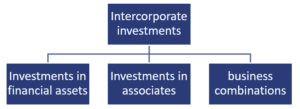Types of Inter-corporate Investments
Intercorporate investments by companies in other companies’ marketable securities are categorized as either (1) investments in financial assets (when the investing firm has no significant control over the operations of the investee firm), (2) investments in associates (when the investing firm has significant influence over the operations of the investee firm, but not control), or (3) business combinations (when the investing firm has control over the operations of the investee firm).
The percentage of ownership (or voting control) is typically used to determine the appropriate category for financial reporting purposes. However, the ownership percentage is only a guideline. Ultimately, the category is based on the investor’s ability to influence or control the investee
On this page, we discuss these three types of inter-corporate investments in more detail.
Investments in Financial Assets
An ownership interest of less than 20% is usually considered a passive investment. In this case, the investor cannot significantly influence or control the investee. IFRS classifies these kinds of investments in financial assets as held-to-maturity, available-for-sale, or fair value through profit and loss.
Investments in Associates
An ownership interest between 20% and 50% is typically a noncontrolling investment; however, the investor can usually significantly influence the investee’s business operations. Significant influence can be evidenced by the following:
- Board of directors representation
- involvement in policy making
- material intercompany transactions
- Interchange of managerial personnel
- Dependence on technology.
It may be possible to have significant influence with less than 20% ownership. In this case, the investment is considered an investment in associates. Conversely, without significant influence, an ownership between 20% and 50% is considered an investment in financial assets.
Business combinations
An ownership interest of more than 50% is usually a controlling investment. When the investor can control the investee, the acquisition method is used. It is possible to own more than 50% of an investee and not have control. For example, control can be temporary or barriers may exist such as bankruptcy or governmental intervention. In these cases, the investment is not considered controlling.
Conversely, it is possible to control with less than 50% ownership interest. In this case, the investment is still considered a business combination.
Joint ventures
A joint venture is an entity whereby control is shared by two or more investors. Both IFRS and US GAAP require the equity method for joint ventures.
Summary
We discussed different types of inter-corporate investments. Different accounting treatments are required depending on the type of intercorporate investment.

